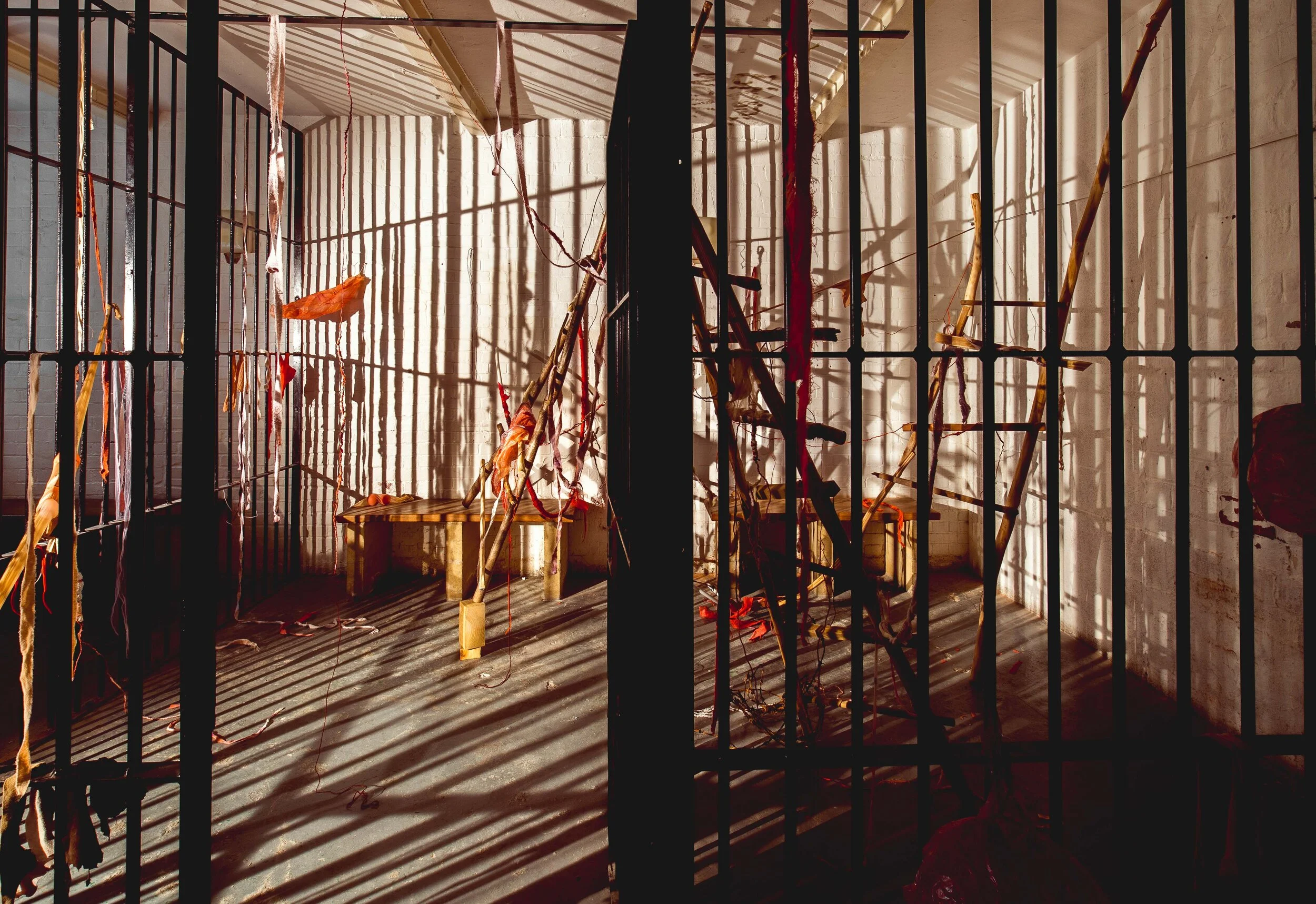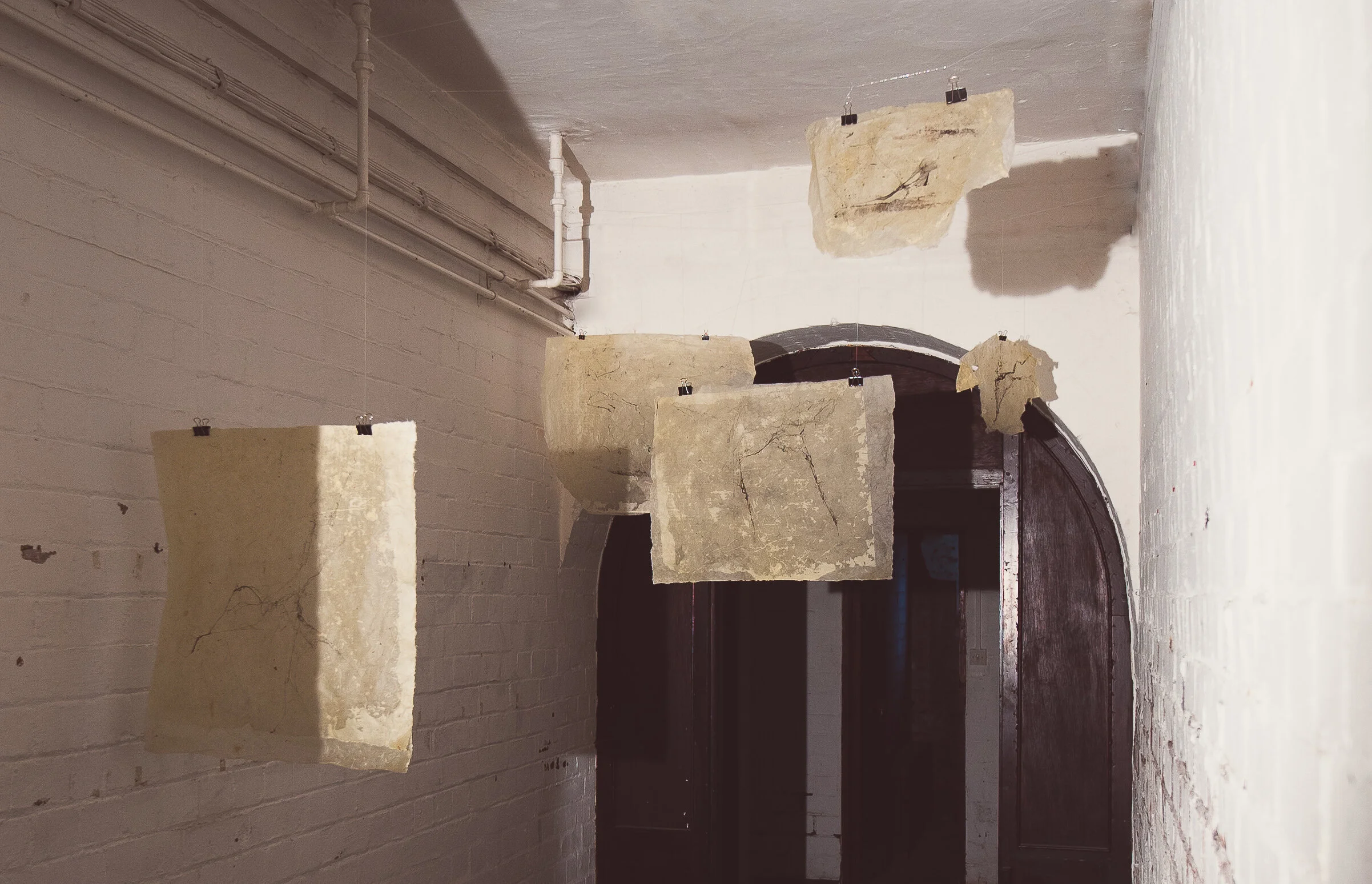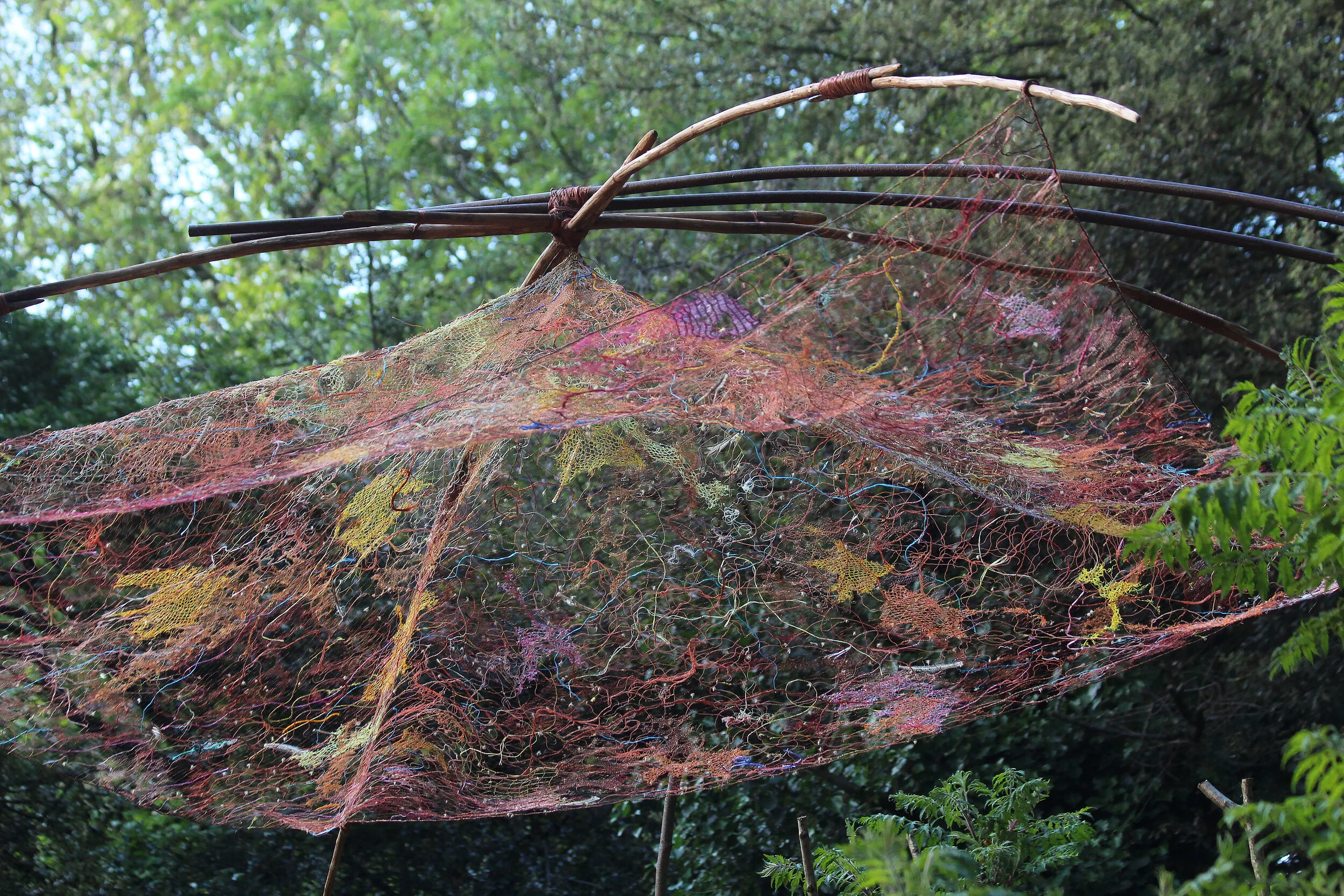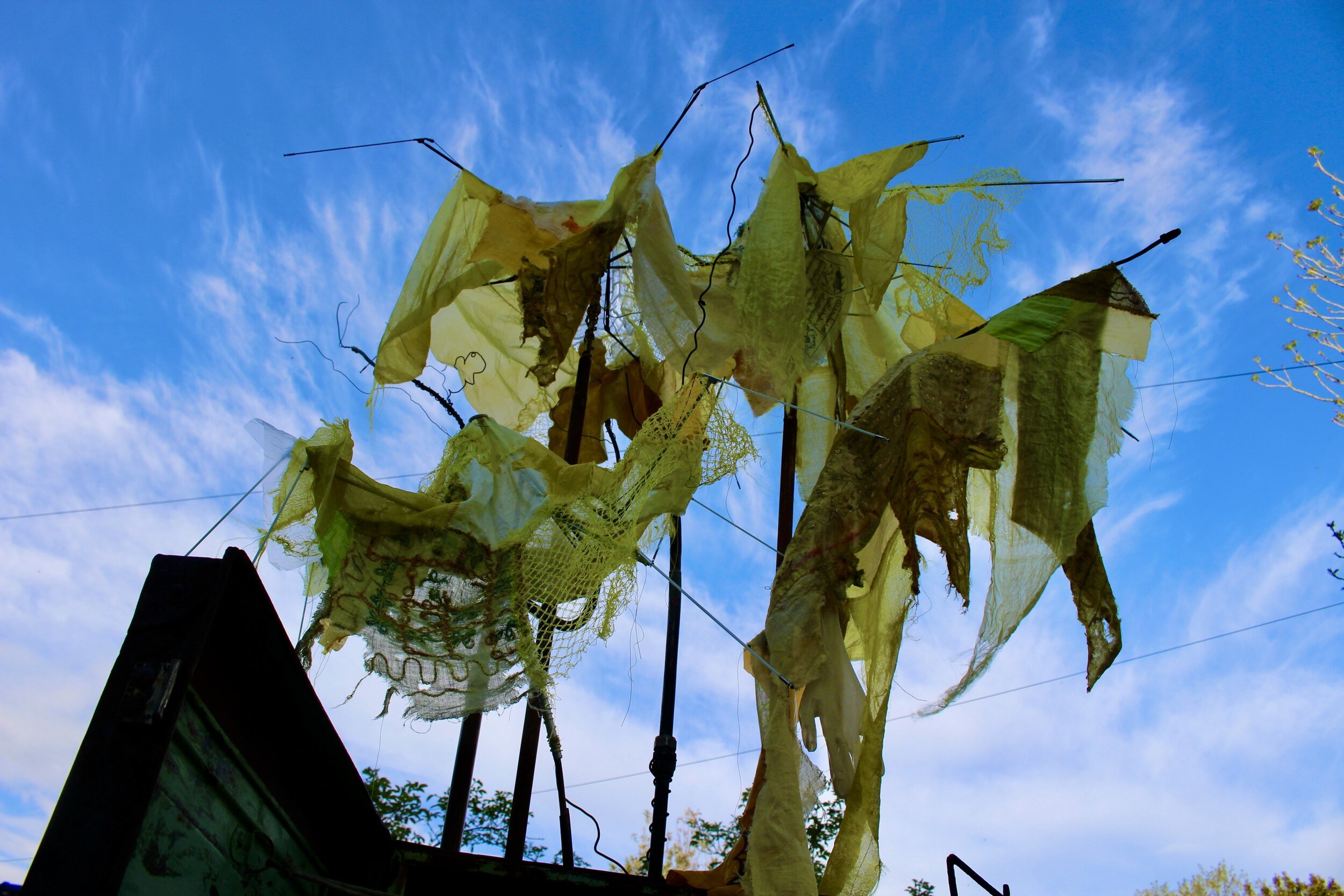



















































270cm (h) x 180cm (w) x 90cm (d) aprx - dimensions can vary depending on site
Found and recycled materials including some with emotional significance (my deceased dog’s toys, blanket, lead, collar, my son’s unwanted stuffed animals), foam, sponge, twine, copper wire, old clothes, fabric (some hand dyed with avocado pits), wool, sisal, string, thread, rope, plastic netting, plastic bags, plaster, handmade khadi paper, paste, wax, linseed oil, steel
2018
‘The tentacular are... fingery beings like humans... squid, jellyfish, neural extravaganzas, fibrous entities, flagellated beings... swelling roots... The tentacular are also nets and networks... Tentacularity is about life lived along lines ... a series of interlaced trails.’ Donna Haraway
Glut is an outpouring, a form of suturing, an emotional response to the recent death of my dog, factory farming, and our plastic oceans.
A ‘curtain’ of tentacular entrails, viscous bodily hybrids transformed, Glut is seductive and disgusting. The materials (especially personal items) speak of past lives, loss, textiles, craft. In contrast, the organic forms symbolise death, violence, but also vulnerability and renewal - the duality of horror and tenderness.
I am interested in tentacularity; rhizomic connections; line as energy: a metaphor for life, vitalism and regeneration. The relationship between micro & macro, how we are part of a complex web.

100cms (height) x 200cms (width) x 150cms (depth)
Recycled and found materials: foam, sponge, twine, copper wire, fabric, leather, wool, plastic netting, sisal, hair, coir, dust, beads, plant fibre, feathers, handmade khadi paper, pva, paste, rabbit skin glue, linseed oil, pigment, steel
2018
Accretion is an accumulation of many parts. Its evolution, the labour-intensive process of its making is an important element in the work. Accretion is an abject object with layers (real and conceptual) and segments that could continue. It has connotations of the intestine, a metaphor for waste, excess and recycling, and other tentacular forms. Like pulling hair out of a plug, it is repulsive, ambiguous.

13m (h) x 9m (w) x 20m (d) aprx. Each ladder ranges from 7.5metres to 3 metres in length
Found and recycled materials: wood, copper wire, chicken wire, cardboard, paper, wax, paste, steel, twine, fabric, wool, sisial, string, thread, plastic
2019
A site-specific large-scale installation created for B-Wing, Shepton Mallet Prison.
Comprising several dysfunctional hand-made ladders and entrail hangings, which interacts with a space.
Snakes and ladders is an ancient game with a moral about fate. Ladders represent imaginary stairways of spiritual ascension, dreams, escape. The precarious ladders and entail forms are inspired by Piranesi’s etching ‘The Bridge’ from ‘The Imaginary Prisons’ series, and relate to my concerns around the endless human cycle of striving, freedom, suffering and waste.
Skeletal structures appear winglike and bone-like, reminiscent of flight and extinct animals hung in museums. In contrast, flesh-coloured handwoven and wrapped entrail forms bewail the realities of destruction and waste surrounding us. Translucent in parts, ghostly, dreamlike, surreal. Layers of reused monochrome collaged newspapers add a frailty, evidence of our consumerist world.
B-Wing was an Arts Council funded project, involving site-responsive artworks, poetry and performances, reflecting the prison’s history, and confronting political and environmental issues.
This work, along with Glut and Accretion, won the Red Line art Works Award in 2020.

MA interim show installation
700cms x 500cms x 400cms aprx
Reclaimed and found materials: copper pipe, copper & steel wire, lead, wood, steel, tissue paper, sugar paper, brown paper, bubble-wrap, netting, twine, sisal, wool, fabric, cling film, chicken wire, broken headphones, cardboard tube, inner tyre tube, aluminium, plastic pipe, tape, mug. Also: plaster, scrim, beeswax, microcrystalline wax
2017
Expansive and playful, created mainly from found and discarded materials, organic and manufactured. The work is inspired by microscopic phenomena – especially particles of spiders’ webs. I was exploring connections between line, growth and energy, weaving a drawing in space, treating line as object – a hybrid that extends line from plane as 3d form. The outcome was in a state of becoming. Referred to in the title, matter (life) is always in a state of flux.
Its evolution - the process of collecting materials, working on site, making is intrinsic to the work, as site- specific. Our global problem of waste and excess is presented in Bataille’s ‘Accursed Share’ and Mike Davis’ ‘Planet of Slums’. I am trying to convey the scientific fact that there is energy in everything. In ‘Wonders of Life’ Brian Cox explains that there is a connection between everything that has lived, as in the Chaos theory. Vitalism, dating back to Aristotle, is a notion (with philosophical and scientific strands) that there is an unknown ‘vital force’ which, together with matter and form, brings life into being. This piece, and the energy I exerted in creating it, was a metaphor for that life force.

90cm x 150cm x 35cm aprx
Charred found objects: wood, bones, feathers, twine, copper wire, steel, miscellaneous
2020
Pyre is a response to the catastrophic Amazon and Australian wildfires. A collection of treasured finds, bound and charred as offerings, grief bundles, remembrances.

Entangled VI
180 (w) x 110 (h) x (d) cm
Recycled and found wood, pondweed, paste, copper, steel
2020
In isolation, appreciating and attending to nature seemed vital. My garden became my world, providing a sense of peace and purpose. Life in the Undergrowth was a project created during lockdown 2020. Inspired by small hidden worlds that get overlooked - garden fed art and art fed garden.
A fascination with entangled roots, worms and shoots in upturned turf led to experimental responses using to-hand materials and found objects. I drew knotted clumps; dried pondweed, sunbleached, became paper; handmade tools from natural debris generated drawings, sculptures evolved and I made films.
While digging to make space for a studio bay, I found a glut of old rusty nails to use in my work. I sold my soil locally - a circular economy. Communing with small creatures, witnessing transformation, life and death, it has been emotional at times. Encounters between myself, garden as site and nature helped me form a stronger bond with all that comes and goes.
Life in the Undergrowth
Digital Film - duration 10:34 mins
2020
To watch film click here
Project supported by Arts Council England/National Lottery Emergency Response Fund

25 (h) x 26 (w) x 27 (d) cm
Recycled steel, chicken wire, copper wire, filter papers, dried duckweed
2020
Part of Life in the Undergrowth

19 (w) x 12.5 (d) x 17 (h) cm
Found objects: nails, dried duckweed
2020
Part of Life in the Undergrowth

88 x 54 x 130cm
Found objects - mixed media: found wood, roots, glass, ceramics, plastic, bones, steel, miscellaneous
2020
One of several pieces created for Life in the Undergrowth. Objects were dug up from the earth in my garden, attached to each other with fine copper wire, suspended on a steel structure. Each find has a story - some known, others a mystery.

250 (h) x 240 (w) x 150 (d) cm
Recycled and found materials: steel, copper, wood, wool, sisal, twine, rope, leaves, feathers, naturally dyed cotton, wax
2021
Inspired by root forms, Icarus, falling, precarity. A reflection of our dystopian world. ‘There are no separable events. The bird and.. branch.. are.. linked creatures..’ (Richard Powers, The Overstory)
Using autumn leaves, charred waxed feathers, and root forms in steel, found wood and wire, it is a drawing in space.
I was reading The Overstory by Richard Powers and Tim Ingold’s book Life of Lines. He talks about how line is the essence of life. Lines put out life, becoming, always in flux. His reference to life’s essentials of line and blob align with my interest in line as a way to describe energy.

Tongue
330cms (l) x 158cms (h) x 135cms (w)
Reclaimed and found materials: fabric, old clothes died with avocado pits, foam, sponge, copper wire, steel, wax, twine, blankets, duvets, pillows, cushion, towels, wool, leather, plastic, rubber, thread
2019
Tongue was created as part of Offenders, a residency and solo exhibition I held in Victorian Cells, Town Hall Arts, Trowbridge, in 2019, later shown in B-Wing, Shepton Mallet prison.
Flesh, organ, waste, body, violence: the huge sculptural tongue, fragile and exposed, activates its space. Revealing the labour and handmade nature of it, Tongue is like a big wounded body, a vulnerable softness juxtaposed against the hardness of its prop, repulsive but seductive.
Tongue confronts uncomfortable topics. It may offend but more importantly, it raises questions - are we all offenders given the state of our world today?
The work was a precursor to ACE-funded B-Wing, which I co-curated in Shepton Mallet Prison later in the year (21 Sept-6 Oct).

Offenders in the Victorian Cells, Town Hall Arts, 2019 was the culmination of an art residency in April. My work responded to the site while confronting environmental horrors we are facing - factory-farming, plastic oceans, animal extinctions. It posed a question ‘are we all offenders given the state of our world?’ I used the residency to test out new ideas and take risks.

Rickety ladders made from found wood were precariously balanced, with wrapped soft sculptural entrails made from recycled materials weaving through them, and dangling from cell bars.

Other works became interventions in smaller spaces and in the corridors. In the toilet, large stone spheres that have been incongruously left on the floor inspired an installation of interconnected cellular/planetary forms like a constellation.
The work included a sound piece - Dawn Chorus - a new direction for me.
I reached out to local community groups to engage through debate and collaborative making.

I made a series of Spiderweb drawings - ancient neglected spider webs captured from dusty corners of the Victorian cells. To become acquainted with the space I spent time creating a large graphite rubbing of a decaying section of brick wall, and some imprints on fine handmade paper, which I oiled, transforming them into skin-like parchment.

Created for step in stone, installed in Westdown Quarry, Somerset. In 2015 I was awarded Arts Council funding for an ambitious project step in stone, involving site-specific artscapes in Mendip quarries with 14 international artists. A major multidisciplinary art event in Somerset, I initiated, curated and featured in it, linking culture, environment and the community.
Cirri
350cms diameter
Locally found and recycled materials: reclaimed steel, aluminium, copper wire, twine, wool, netting, rope
2015
My inspiration is the tenacity and diversity of life and the similarities of form that occur in different organisms. This work is based on plantlike crinoids (sea lilies) - ancient sea creatures whose fossilised remains are common in carboniferous limestone and whose descendants can still be found living today. Crinoid tentacles are reminiscent of branches, tendrils, feathers or the microscopic patterns of neurons. They cling to the seabed (some now vertical rock faces) by long spiny stems, others are without a stalk but have tentacle legs or long arms to drag themselves along.

350 x 950cms
scrap steel found in quarries, wire, paper, wax, string, wool, nylon, cotton, oil
2015
Created for step in stone, installed in Fairy Cave Quarry.
A ghost cave delineating the site where it is believed connecting caves once existed between Withyhill and Hillwithy caves. Through quarrying, some caves were destroyed, others discovered. These caves are renowned for their exquisite speleothems (stalactites, stalagmites, helictites..).

7ms diameter. Scale varies, according to site
Reclaimed and found materials: steel, copper, lead, twine, wire, plastic netting, & nitrate
2013
Lichen was originally created for the Abundance Garden Trail, 2013, a Somerset Art Works/National Garden Scheme site-specific commission. Inspired by my appointed garden Esotera, in Foddington, Somerset, I created the Garden of Eden, an installation based on the idea of nature’s repossession. The Garden of Eden was almost tangible at Esotera. Transformed from nothing into an idyllic environment, abundant with creatures and plants living harmoniously, the garden emanated a Utopian ideal. The root meaning of Esotera is 'of the earth’. My work related to some of the textures and forms, nature’s return to Eden, using vibrant found and reclaimed materials collected from the area.
A large piece spanning 7 metres, it was set in an enclosure of silver birch trees.
Welded, woven and wrapped, the forms took shape in response to this garden of earthly delights – lovingly nurtured by its owners and adopted as their home by a diversity of wild life.
I wanted to surprise, inspire and engage all ages. Working with a plethora of found and reused materials, my challenge was to create a garden of eden that was in itself abundant, evoking ancient, primal forms, the cycle and triumph of life.
Sunlight really made the work glow with mirrored dappled autumn colours. Even the rain created its own dimension; melodies of sounds tinkling on metal surfaces, dew drops reflected and it was thrilling to watch new shoots emerge - serendipity that magnificent fungi should sprout through work inspired by lichen.
Later installed in different sites including Sidcot Arts Centre, Glastonbury Abbey orchard and Somerset Earth Science Centre

4m diameter
Recycled and found materials: Copper wires, plastic cables, fruit nets, twine, wool, silk from Cambodia, fish bones, feathers
2016
Commissioned by multi gold-award winning landscape designer Sarah Eberle FSGD as a focal piece for her RHS Chelsea Flower Show Viking Cruises Mekong Garden in 2016. The artisan garden was inspired by Cambodia’s floating gardens and artisanal fishing techniques in the Mekong River region. I created the textured canopy by hand-weaving fine copper wires to construct the base net structure, then layering and weaving into this with found and recycled objects including fruit netting bags, silk reels brought back from Cambodia, and fish skeletons.
Fiona was approached by Sarah after seeing my installation Lichen at the Maureen Michaelson Gallery stand at GROW London 2015. I also made 3 wire baskets as props.
The garden won gold and best artisan garden.

230 (h) x 120 (w) x 105 (d)
Recycled materials: steel, copper, fabric, plastic, twine, wire, umbrellas, metal trunk
2021
Hope of a Tree comes in disparate parts which are packed into the trunk, and erected in situ. Created for for Inch by IN:CH, an artist-led travelling project. 11 artists are each making work in a case, which we are transporting to non-gallery spaces around South West UK from May-October. It’s about taking work into the heart of the community.
The antique metal (military) trunk is the base from which vertical forms will extend, when opened. From containment, constriction, to regeneration. Rising up beyond the grid: branching forms, umbrella structures, hand stitched patches of textiles and plastic. The translucent textiles offer a vibrant material language, though precarious. Stitch references repair in response to world destruction. Yellow is for hope and optimism..
I’ve gathered the materials from my locality, friends and neighbours.